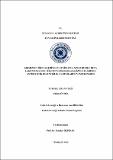Please use this identifier to cite or link to this item:
http://hdl.handle.net/11547/5168Full metadata record
| DC Field | Value | Language |
|---|---|---|
| dc.contributor.author | Öndeş, Nilüfer | - |
| dc.date.accessioned | 2019-08-15T08:17:55Z | - |
| dc.date.available | 2019-08-15T08:17:55Z | - |
| dc.date.issued | 2015 | - |
| dc.identifier.uri | http://hdl.handle.net/11547/5168 | - |
| dc.description.abstract | Enterobacteriaceae Gram (-) bakterilerde Genişlemiş Spektrumlu Beta Laktamazların (GSBL) görülme sıklığı tüm Dünya’ da hızlı bir şekilde artış göstermektedir. Antibiyotiklerin aşırı ve bilinçsiz kullanımı bu durumun karmaşıklaşarak artmasına yol açmaktadır. Gıda amaçlı yetiştirilen hayvanlarda ve bu hayvanlardan elde edilen ürünlerde GSBL üreten enterik bakterilerin varlıklarına daha sık şekilde rastlanmaktadır. Genetik materyaller sayesinde hızla yayılan türdeş ya da farklı tip bakterilere transfer edilebilen beta laktamazların başlıca bulaşma kaynakları arasında fekal bulaşma ve yeterince pişirilmeden tüketilen kırmızı etler ve et ürünleri gelmektedir. Bu çalışmada, İstanbul ili ve Marmara Bölgesi’ nde yerleşik diğer illerden toplanan (Bursa, Tekirdağ, Yalova) toplam 110 adet çiğ kırmızı et numunelerinde (65 dana ve 45 koyun) GSBL üreten enterobakterilerin fenotipik yöntemler kullanılarak tespiti amaçlanmıştır. Kırmızı et numune materyalleri Enterobactericeae buyyonda ön zenginleştirme işlemine alınarak 37°C’ de inkübasyona alınmıştır. Bu işlemi takiben kromatik GSBL selektif medya kullanarak tekrar gece aşırı inkübasyona bırakılarak selektif zenginleştirme aşamasına geçilmiştir. Selektif besiyerinde gelişen şüpheli GSBL izolatlar altkültür edilerek saflaştırılmışlar ve VITEK®MS (bioMérieux) cihazında tiplendirmeleri yapılmıştır. Tiplendirmesi yapılan şüpheli GSBL izolatlar GSBL varlıkları bakımından sırasıyla disk difüzyonu, disk difüzyonu konfirmasyonu ve GSBL doğrulama için antibiyogram doğrulama ve MİK tespiti analizlerine alınmıştır. Sonuçlar tüm numune materyallerde %20,9 (n=23) GSBL prevelansı tespit edilirken, izole edilen başlıca mikroorganizmalar E. coli (%30), C. braakii (%22), E. cloacae (%17), K. pneumoniae (%9), C. freundii (%9), S. fonticola (%4), K. intermedia (%4) ve Moellerella wisconsensis (%4) olarak belirlenmiştir. Bu çalışmada, insan beslenmesinde çok önemli olan kırmızı etin GSBL üreten enterik bakterilerle bulaşmış olduğu ve bu durumun halk sağlığı bakımından önemli bir risk teşkil ettiği görülmüştür. | tr_TR |
| dc.language.iso | tr | tr_TR |
| dc.publisher | İSTANBUL AYDIN ÜNİVERSİTESİ FEN BİLİMLERİ ENSTİTÜSÜ | tr_TR |
| dc.subject | Antibiyotik Direnci | tr_TR |
| dc.subject | Enterobacteriaceae | tr_TR |
| dc.subject | Et | tr_TR |
| dc.subject | GSBL | tr_TR |
| dc.subject | Halk Sağlığı | tr_TR |
| dc.subject | Antibiotic Resistant | tr_TR |
| dc.subject | Enterobacteriaceae | tr_TR |
| dc.subject | Meat | tr_TR |
| dc.subject | ESBL | tr_TR |
| dc.subject | Public Health | tr_TR |
| dc.title | KIRMIZI ET ÖRNEKLERİNDEN GENİŞLEMİŞ SPEKTRUMLU BETA LAKTAMAZ (GSBL) ÜRETEN Enterobacteriaceae İZOLATLARINDA ANTİBİYOTİK DİRENÇLİLİK DURUMLARININ İNCELENMESİ | tr_TR |
| dc.type | Thesis | tr_TR |
| dc.description.abstractol | The prevalence of extended spectrum beta lactamases (ESBLs) in the family of Gram (-) Enterobacteriaceae has been emerging all over the World. The off-label use of them causes severe un-anticipated adverse effects including development of resistance in the bacteria. Hence, the presence of ESBL producing enterobacteria within the food producing animals are increasingly detected at the present time. The genetic elements responsible for encoding these beta-lactamases are the major contributors for the dissemination of ESBLs among the same and/or different bacterial species through feces and the consumption of insufficiently cooked meats and meat-products. The objective of this study was to determine the presence of ESBL producing Enterobacteriaceae isolated from a total of 110 raw meat samples (65 cow and 45 sheep) in Istanbul and different districts (Bursa, Tekirdag, Yalova) of the region of Marmara using phenotypic methods. All the samples were homogenized in Enterobacteriaceae enrichment broth, followed by an incubation at 37°C overnight. The pre-enriched samples were subjected to selective enrichment in Chromagar ESBL selective media with an icubation at 37°C for 18-24 hours. The presumptive isolates were subcultured at tryptone soy agar, and identified by VITEK®MS (bioMérieux). The identified presumptive isolates were screened for the existence of ESBLs using a combination of CTX, CAZ and CPD antibiotic dics with/without CLA according to the guidelines of CLSI (2013). The final confirmation was performed by liquid microdilution method based on MIC determination. The results showed that overall, 20,9% (n=23) of the screened isolates were positive for ESBL. The distribution of the species were found to be E. coli (30%), C. braakii (22%), E. cloacae (17%), K. pneumoniae (9%), C. freundii (9%), S. fonticola (4%), K. intermedia (4%) and Moellerella wisconsensis (4%), respectively. In summary, the meats, essentially required for the human nutrition, were significantly contaminated with ESBL producing Enterobacteriaceae, and therefore presented a risk for the public health. | tr_TR |
| dc.publisher.firstpagenumber | 1 | tr_TR |
| dc.publisher.lastpagenumber | 76 | tr_TR |
| dc.identifier.bibliographictag | Öndeş, Nilüfer, KIRMIZI ET ÖRNEKLERİNDEN GENİŞLEMİŞ SPEKTRUMLU BETA LAKTAMAZ (GSBL) ÜRETEN Enterobacteriaceae İZOLATLARINDA ANTİBİYOTİK DİRENÇLİLİK DURUMLARININ İNCELENMESİ (2015), İSTANBUL AYDIN ÜNİVERSİTESİ FEN BİLİMLERİ ENSTİTÜSÜ | tr_TR |
| Appears in Collections: | Tezler -Thesis | |
Files in This Item:
| File | Description | Size | Format | |
|---|---|---|---|---|
| 10073352.pdf | 3.52 MB | Adobe PDF |  View/Open |
Items in DSpace are protected by copyright, with all rights reserved, unless otherwise indicated.
